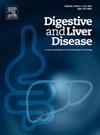肝移植受者长期随访(bbb20年)的多维脆弱性评估:ELITA/ELTR项目的RESIST研究的初步结果
IF 3.8
3区 医学
Q1 GASTROENTEROLOGY & HEPATOLOGY
引用次数: 0
摘要
背景:长期接触免疫抑制剂可能会加速衰老,其方式没有反映在实际年龄上。虚弱可以被认为是生物学年龄的替代品,可以使用多维虚弱指数来评估,该指数探索了肝功能、功能状态、认知、合并症和身体表现等各种缺陷。目的评估存活超过20年的成人肝移植(LT)受者的多维脆弱性,并将其与相同年龄和性别的普通人群进行比较,并评估脆弱性对生活质量(QoL)的影响。方法采用多中心、横断面研究,比较2005年1月1日前在不同肝移植中心接受肝移植的患者和定期随访的肝移植患者的衰弱和生活质量,并以年龄相近、未接受肝移植的老年或肝病诊所患者作为对照组。虚弱程度的评估使用虚弱指数(FI-39)的更新版本,现在称为ELITA FI-35,其计算方法为患者存在健康缺陷的数量(存在=1,不存在=0)与考虑的缺陷总数(35)之比。生活质量通过自动填写的EQ-5D-5L问卷进行评估。结果:我们纳入了99例LT长期存活患者,对照41例。肝移植受体ELITA FI-35的中位数(IQR)为0.26(0.17-0.31),对照组为0.14 (0.11-0.20)(p <0.001)。在LT组和对照组中,年龄与ELITA FI-35之间存在中等相关性(图1),显示两组随着年龄的增加评分逐渐恶化。LT组各年龄组的评分差异有统计学意义(age& LT;65: 0.14 [0.11, 0.18]; 65& LT;age& LT;75: 0.26 [0.17, 0.31]; age& LT;75: 0.29 [0.23, 0.31], p<0.001)。除肝功能外,观察到病例与对照组之间最大的差异是在身体表现和认知领域,特别是:需要帮助家务(14%对0%,p=0.03),平衡障碍(20%对5%,p=0.04),记忆抱怨(24%对7%,p=0.4)和失眠(32%对12%,p=0.03)。然而,EQ-5D-5L测量的生活质量(中位[IQR]: 78[65-85],对照组75 [70-85],p=0.793)和急诊住院率(30%对20%,p=0.272)均无显著差异。结论:长期肝移植患者的虚弱负担高于对照组,尤其是在身体和认知领域,随着年龄的增长,虚弱程度显著增加。然而,各组之间相似的生活质量评分表明,LT接受者保持着良好的幸福感。本文章由计算机程序翻译,如有差异,请以英文原文为准。
Multidimensional frailty assessment of liver transplant recipients with long term follow-up (>20 years): preliminary results of the RESIST study an ELITA/ELTR project
Background
chronic exposure to immunosuppressants may accelerate aging in ways not reflected by chronological age. Frailty may be considered a surrogate of biological age and can be assessed using a multidimensional frailty index which explores various deficits across liver function, functional status, cognition, comorbidities and physical performance.
Aims
to assess the multidimensional frailty of adult liver transplant (LT) recipients surviving longer than 20 years compared with the results obtained in the general population of similar age and gender, and to assess the impact of frailty on Quality of Life (QoL).
Methods
we conducted a multicenter, cross-sectional study comparing frailty and QoL of LT patients transplanted before 01/01/2005 and in regular follow-up at different LT Centers, with a control group of non-transplanted subjects of similar age, enrolled in geriatric or hepatological clinics. Frailty was assessed using an updated version of the Frailty Index (FI-39) and now called ELITA FI-35, which is calculated as the ratio of the number of health deficits present in a patient (presence=1, absence=0) with the total number of considered deficits, being 35. QoL was assessed though the auto-administered questionnaire the EQ-5D-5L.
Results
we included 99 LT long-survivor patients compared to 41 controls. Median (IQR) ELITA FI-35 in LT recipients was 0.26 (0.17-0.31) vs. 0.14 (0.11-0.20) in the control group (p <0.001). A moderate correlation was found between age and ELITA FI-35 both for the LT and for the control group (Figure 1), showing a progressive worsening of the score in both group while age increase. The score was significantly different among age categories for the LT group (age<65: 0.14 [0.11, 0.18]; 65<age<75: 0.26 [0.17, 0.31]; age>75: 0.29 [0.23, 0.31], p<0.001). Beyond liver function, the largest differences between cases and controls were observed in physical performance and cognitive domains, particularly: need for help with housekeeping (14% vs. 0%, p=0.03), balance disorders (20% vs. 5%, p=0.04), memory complaints (24% vs. 7%, p=0.4), and insomnia (32% vs. 12%, p=0.03). However, no significant differences were found in QoL measured by the EQ-5D-5L (median [IQR]: 78 [65–85] in LT patients vs. 75 [70–85] in controls, p=0.793), nor in emergency hospital admission rates (30% vs. 20%, p=0.272)
Conclusion
long-term LT recipients showed a higher frailty burden than controls, especially in physical and cognitive domains, with frailty increasing significantly with age. Nevertheless, similar QoL scores between groups suggest that LT recipients maintain a preserved perception of well-being.
求助全文
通过发布文献求助,成功后即可免费获取论文全文。
去求助
来源期刊

Digestive and Liver Disease
医学-胃肠肝病学
CiteScore
6.10
自引率
2.20%
发文量
632
审稿时长
19 days
期刊介绍:
Digestive and Liver Disease is an international journal of Gastroenterology and Hepatology. It is the official journal of Italian Association for the Study of the Liver (AISF); Italian Association for the Study of the Pancreas (AISP); Italian Association for Digestive Endoscopy (SIED); Italian Association for Hospital Gastroenterologists and Digestive Endoscopists (AIGO); Italian Society of Gastroenterology (SIGE); Italian Society of Pediatric Gastroenterology and Hepatology (SIGENP) and Italian Group for the Study of Inflammatory Bowel Disease (IG-IBD).
Digestive and Liver Disease publishes papers on basic and clinical research in the field of gastroenterology and hepatology.
Contributions consist of:
Original Papers
Correspondence to the Editor
Editorials, Reviews and Special Articles
Progress Reports
Image of the Month
Congress Proceedings
Symposia and Mini-symposia.
 求助内容:
求助内容: 应助结果提醒方式:
应助结果提醒方式:


